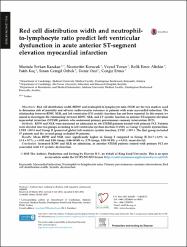Red cell distribution width and neutrophil-to-lymphocyte ratio predict left ventricular dysfunction in acute anterior ST-segment elevation myocardial infarction

View/
Access
info:eu-repo/semantics/openAccessDate
2016Author
Karakas, Mustafa SerkanKorucuk, Necmettin
Tosun, Veysel
Altekin, Refik Emre
Koc, Fatih
Ozbek, Sinan Cemgil
Ozel, Deniz
Metadata
Show full item recordAbstract
Objectives: Red cell distribution width (RDW) and neutrophil-to-lymphocyte ratio (NLR) are the two markers used to determine risk of mortality and adverse cardiovascular outcomes in patients with acute myocardial infarction. The relationship between RDW, NLR, and left ventricular (LV) systolic functions has not been reported. In this report, we aimed to investigate the relationship between RDW, NLR, and LV systolic function in anterior ST-segment elevation myocardial infarction (STEMI) patients who underwent primary percutaneous coronary intervention (PCI). Methods: RDW and NLR were measured on admission in 106 STEMI patients treated with primary PCI. Patients were divided into two groups according to left ventricular ejection fraction (LVEF), as Group I (systolic dysfunction, LVEF <50%) and Group II (preserved global left ventricle systolic function, LVEF >= 50%). The first group included 47 patients and the second group included 59 patients. Results: Mean RDW and NLR were significantly higher in Group I compared to Group II [13.7 +/- 0.9% vs. 13.4 +/- 0.7%, p = 0.03 and 5.86 (range, 0.66-40.50) vs. 2.75 (range, 0.51-39.39), p = 0.013, respectively]. Conclusion: Increased RDW and NLR on admission, in anterior STEMI patients treated with primary PCI are associated with LV systolic dysfunction. (C) 2015 The Authors. Production and hosting by Elsevier B.V. on behalf of King Saud University.

















